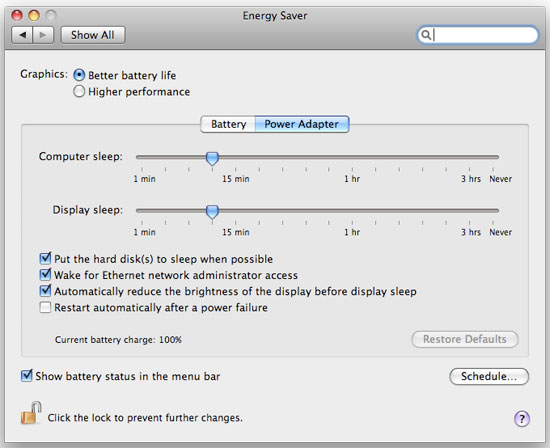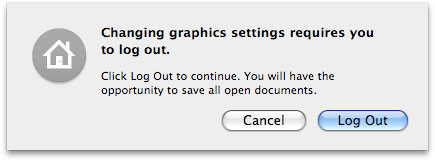Apple's Redesigned MacBook and MacBook Pro: Thoroughly Reviewed
by Anand Lal Shimpi on October 22, 2008 12:00 AM EST- Posted in
- Mac
Two GPUs
While the MacBook relies on the integrated GeForce 9400M, the MacBook Pro includes a discrete GPU as well (NVIDIA calls this a dGPU and the integrated one the mGPU): a GeForce 9600M. The 9600M features 32 SPs up from 16 in the 9400M, giving it more shader power and it's got its own dedicated frame buffer off of a 128-bit memory bus. The dedicated frame buffer is quite possibly the most important but the usefulness here is pretty much limited to games (which are mostly going to be Windows-only) and the high end professional applications that are GPU accelerated.

Apple gives you the option of switching between the two GPUs in the Energy Saver preference pane; unfortunately you have to log out and log back in to switch between the dGPU and mGPU. Other PC implementations of Hybrid Power (what NVIDIA calls the ability to turn off the dGPU and rely on just the mGPU) aren't so clumsy and can be done from within Windows, but for whatever reason Apple requires a logout/login.

The mGPU is preferable for battery life as you'll see in the section on battery life shortly.
Pulling an Apple out of a Hat: DisplayPort Standard
Apple has a tendency of doing this thing where it adopts new standards and gets rid of old ones well before their time is up. It's admirable and it allows Apple to pull off some neat tricks, but as Apple is a much larger manufacturer today than it was in the past we're starting to see examples of why companies like Dell don't take a similar approach.
Case in point is the video output on these two notebooks we're looking at today. Apple had a DVI output on its MacBook Pro but the connector itself was a little too big for the form factor changes that Apple wanted to implement. On the MacBook Air Apple used a mini DVI output, but on the new MacBook and MacBook Pro we have a mini DisplayPort connector.

The mini DisplayPort connector is to the left of the mic-input
Unfortunately only Apple uses mini DisplayPort on its recently introduced 24" display; Dell still uses the full sized DisplayPort connector on its monitors - not to mention the many more that use standard DVI or VGA.
Apple's solution is to offer mini-DP to DVI, DVI, or DL-DVI adapters, which is acceptable; unfortunately neither notebook ships with a single adapter. In the long term this will hopefully be a non-issue, but until then be prepared to spend another $30 or $100 (dual-link DVI) to support an external display.










66 Comments
View All Comments
Calin - Friday, October 24, 2008 - link
What about testing power use under XP I meanXP compares more favourably to Mac OS (or anything else) than Vista, and I wanted to know if that excessive power use is Vista-only, or if it does appear on Windows XP too
strikeback03 - Thursday, October 23, 2008 - link
Or some version of Linux?wilkinb - Wednesday, October 22, 2008 - link
yeh I agree the diff will be how the OS is set to manage each device etc etc...On my Sony laptop i get around 2 hours on high performance and a bit over 5 hours on battery saving...
The results they posted dont really tell us much other then a bootcamp vista install isnt as good as an osx install at managing power on apple laptop... amazing right?
I am sure if i dont use the Sony install and tool/drviers etc I will also get less battery life on my laptop. So the question would be do you think apple put more effort into power management on their OSX install then they did for Vista?
JarredWalton - Wednesday, October 22, 2008 - link
Let me just say that I've tried testing various power saver setting under Vista on several notebooks (see review on Friday) and I just can't get anywhere near 5 hours of battery life. Sure, the CPUs are a bit higher spec on some of the notebooks, but as one example a 12.1" laptop with 55 Whr battery, 320GB 5400RPM HDD, 4GB RAM, LED backlighting, and P8400 pulls an "amazing" 138 minutes of DVD playback and 142 minutes of web surfing... though it does manage 261 minutes when sitting idle at the desktop.As best I can tell, the CPU and HDD just don't seem to be entering sleep modes much if at all, unless the system is 100% idle. Even then, 261 minutes idle battery life doesn't compare favorably to the MacBook pulling 286 minutes of web surfing.
How big is the Sony battery, if I may ask? (Just for reference, take Voltage * mAhr to get Whr.) What sort of CPU, GPU, HDD, RAM does it use? What we need to see to prove it's possible is a Vista laptop with a 20W TDP CPU, 2GB RAM, 5400 RPM HDD, and 13.3" LED backlit LCD that can still get close to five hours of battery life with a 55 Whr battery. If you think you have one, get the manufacturer to send me one for review! :)
Spivonious - Thursday, October 23, 2008 - link
Are you guys turning off the Vista indexer and SuperFetch? Those two things would run the harddrives pretty constantly on a fresh install, which would definitely drag down battery life.JarredWalton - Thursday, October 23, 2008 - link
Do normal users disable SuperFetch? I've disabled indexing as much as I know how, since I don't use it, but SuperFetch is part of Vista. Besides, it shouldn't run on battery power (and neither should indexing).Spivonious - Friday, October 24, 2008 - link
If you want to actually test Vista battery life, install the OS and use it for a week before testing the battery life. I agree with the other poster that both the indexer and SuperFetch are great features, but they do spin the harddrive when the computer is idle until the index is built and SuperFetch learns what you use most often.Spinning harddrive = lower battery life
Comparing battery life between Vista and OS X is like comparing the time it takes to eat a pomegranate and an apple.
headbox - Saturday, October 25, 2008 - link
no, battery tests let people know how long they can use their computer without plugging it in.You're not comprehending the article- the PC laptops are also being tested at idle, just sitting there doing nothing. If Vista is going to spend that entire time "superfetching" nothing, that's a problem.
jonmcc33 - Thursday, October 23, 2008 - link
No, normal users do not disable SuperFetch. That's just bad tweaking advice, as much as turning Indexing off is as well. Both are amazing features added to Vista.I tested a Latitude D630 (2.6GHz Core 2 Duo Penryn, 2GB RAM) with Vista Business and a 9-cell 85WHr battery. Life was over 5 hours.
JarredWalton - Thursday, October 23, 2008 - link
I wouldn't be surprised if there's just some glitch on many of the laptops that's keeping battery life down, but until some manufacturer can deliver Vista with 55 Whr and 5 hours (give or take) battery life I remain skeptical. Users shouldn't have to hack their laptop in any way to get the increased battery life; it should just work properly out of the box. You know, like the MacBooks with OS X.